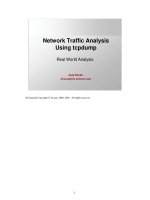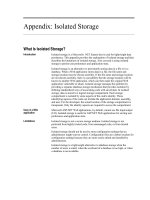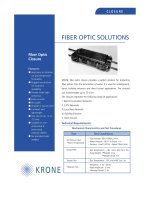Tài liệu Firewall Configuration Forms doc
Bạn đang xem bản rút gọn của tài liệu. Xem và tải ngay bản đầy đủ của tài liệu tại đây (150.16 KB, 8 trang )
A-1
Cisco PIX Firewall and VPN Configuration Guide
78-13943-01
APPENDIX
A
Firewall Configuration Forms
Installing PIX Firewall requires a thorough knowledge of your company’s network topology and
security policy. To get the PIX Firewall running immediately, fill in the information in Table A-1 to
Table A-4, and proceed to Chapter 2, “Establishing Connectivity.” To configure the PIX Firewall for
specific types of network traffic, fill in the information in Table A-5 through Table A-8, and follow the
instructions in Chapter 3, “Controlling Network Access and Use.”
Information may not appear in the same order in the forms as it does in a configuration listing. The Cisco
PIX Firewall Command Reference provides the complete syntax for all PIX Firewall commands.
This appendix includes the following sections:
•
PIX Firewall Network Interface Information
•
Routing Information
•
Network Address Translation
•
Static Address Translation
•
Inbound Access Control
•
Outbound Access Control
•
Authentication and Authorization
For specific information about your network environment, contact your network administrator.
A-2
Cisco PIX Firewall and VPN Configuration Guide
78-13943-01
Appendix A Firewall Configuration Forms
PIX Firewall Network Interface Information
PIX Firewall Network Interface Information
Each PIX Firewall has two or more physical network interfaces. Configure each interface with an IP
address, network speed, maximum transmission unit (MTU) size, and so on. Refer to the interface
command page within the Cisco PIX Firewall Command Reference for complete information on the
interface command. Table A-1 provides a form for entering PIX Firewall network interface information.
Routing Information
Table A-2 provides a form for entering route information. Refer to the Cisco PIX Firewall Command
Reference for complete information on the route command and the rip command. The router IP
addresses should not be the same as the PIX Firewall interface IP address, or the same as any global
address specified in Table A-3.
Table A-1 PIX Firewall Network Interface Information
Interface
Name Interface Type
Hardware
ID
Interface
IP Address
Interface
Speed MTU Size
Interface
Security Level
Outside 0
Inside 100
Table A-2 Routing Information
Interface Name
Destination
Network IP
Address Network Mask
Gateway (Router)
IP Address
(RIP) Enable
Passive Listening
for Routing
Information?
(Yes, No)
(RIP)
Broadcast This
Interface as a
Default Route?
(Yes, No)
A-3
Cisco PIX Firewall and VPN Configuration Guide
78-13943-01
Appendix A Firewall Configuration Forms
Network Address Translation
Network Address Translation
Table A-3 provides a form for gathering the global address pool information. Table A-4 links internal
network addresses with the global pool information. The information in Tables A-3 and A-4 work
together to set up NAT and PAT on the PIX Firewall. Refer to the Cisco PIX Firewall Command
Reference for complete information on the global and nat commands.
Table A-4 maps internal (inside) or perimeter network addresses with global network addresses on other
interfaces in the PIX Firewall.
Table A-3 Outside (Global) Network Address or Address Range
Outside or
Perimeter
Interface Name
NAT ID Number
from Table A-3
Beginning of IP
Address Range
End of IP Address
Range (Optional)
1
1. Do not enter an ending IP address for PAT assignments. PAT uses only a single IP address.
Comments
Table A-4
Inside (Local) or Perimeter Network Address Translation
Inside or
Perimeter Name
from Table A-1
NAT ID Number
(1 to 65,000)
Network Address
Mapped to the
NAT ID
Network Mask for
This Address Comments
A-4
Cisco PIX Firewall and VPN Configuration Guide
78-13943-01
Appendix A Firewall Configuration Forms
Static Address Translation
Static Address Translation
We recommend completing the information in Tables A-1 to A-4 and completing the instructions
provided in Chapter 2, “Establishing Connectivity” before attempting advanced configuration. After
completing and testing your basic configuration, complete the information in Table A-5, which defines
advanced configuration settings for static address mapping. Then refer to Chapter 3, “Controlling
Network Access and Use,” for instructions about how to use this information. Refer to the
Cisco PIX Firewall Command Reference for complete information on the static command.
Note
Static addresses should not be members of the global address pool specified in Table A-3. If the internal
host requires Internet access, the static address should be a NIC-registered address.
Table A-5 Static Address Mapping
Interface on
Which the
Host Resides
Interface Name
Where the
Global Address
Resides Host IP Address Static IP Address Comments
A-5
Cisco PIX Firewall and VPN Configuration Guide
78-13943-01
Appendix A Firewall Configuration Forms
Inbound Access Control
Inbound Access Control
Before attempting advanced configuration, we recommend completing the information on Tables A-1 to
A-4 and completing the instructions provided in Chapter 2, “Establishing Connectivity.” After
completing and testing your basic configuration, complete the information in Table A-6, which defines
advanced configuration settings for inbound access control. Then refer to Chapter 3, “Controlling
Network Access and Use,” for instructions about how to use this information. Refer to the
Cisco PIX Firewall Command Reference for complete information on the access-list and access-group
commands.
To control access by IP address, configure an access-list command statement. To control access by user,
set up authentication, as shown in Table A-8. A global or static address should exist for an internal host
or network before you can set up a access-list command statement. See Tables A-3 and A-5 to configure
a global or static entry for an internal host.
The following is a list of literal port names that you can use when configuring an access-list command
statement: DNS, ESP, FTP, H323, HTTP, IDENT, NNTP, NTP, POP2, POP3, PPTP, RPC, SMTP, SNMP,
SNMPTRAP, SQLNET, TCP, Telnet, TFTP, and UDP. You can also specify these ports by number. Port
numbers are defined in RFC 1700.
You should have two access-list command statement definitions to permit access to the following ports:
•
DNS, Discard, Echo, Ident, NTP, RPC, SUNRPC, and Talk each require one definition for TCP and
one for UDP.
•
PPTP requires one definition for port 1723 on TCP and another for port 0 and GRE.
•
TACACS+ requires one definition for port 65 on TCP and another for port 49 on UDP.
Table A-6 Inbound Access Control
Access
List
Identifier
Permit
or Deny
Network
Protocol:
UDP,
TCP,
ICMP,or
Number
Source Address:
External Host or
Network IP Address(es)
and Network Mask
Destination Address:
Static IP Address and
Network Mask from Table
A-5
1
Destination
Ports
2
Interface
To
Bind List
1. Use the keyword “any” to specify all global IP addresses.
2. To specify a single port or a range of ports, you can use operands: greater than, less than, equal, not equal, and range.









